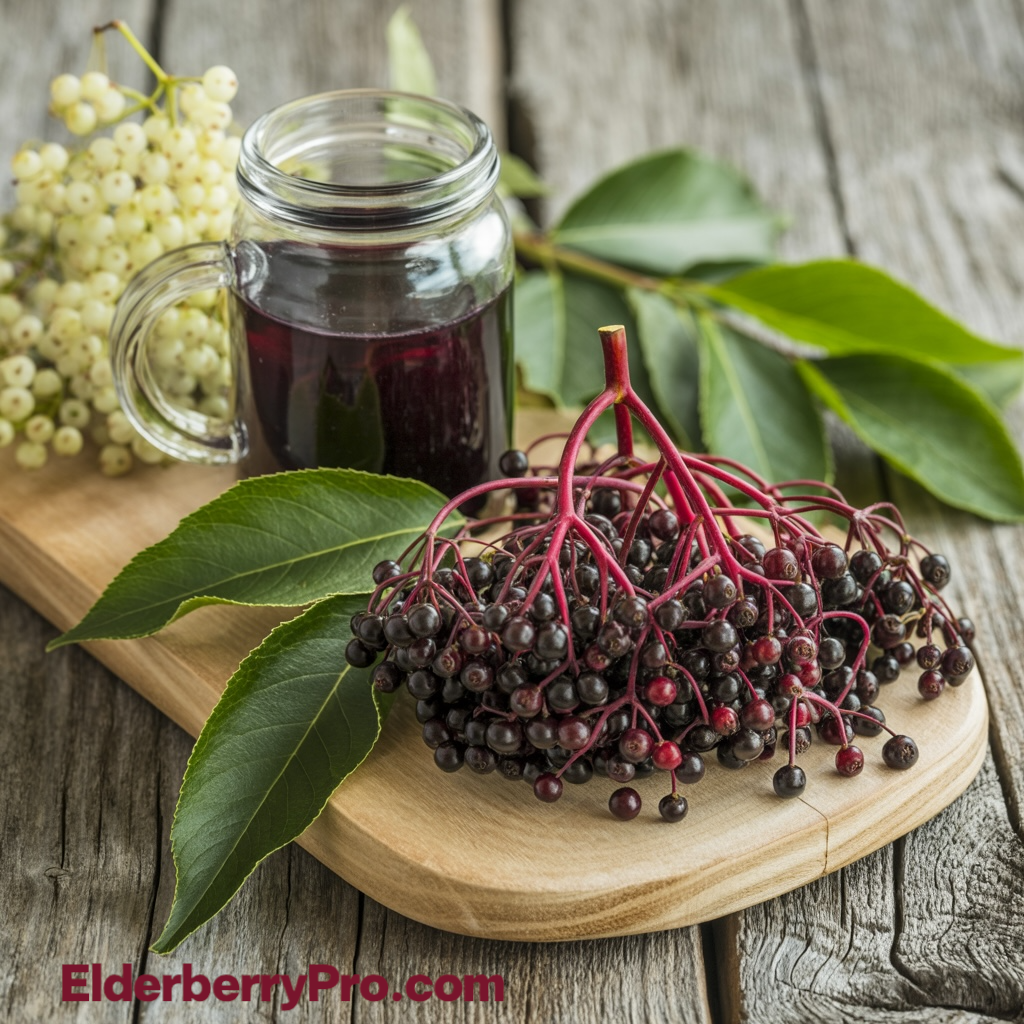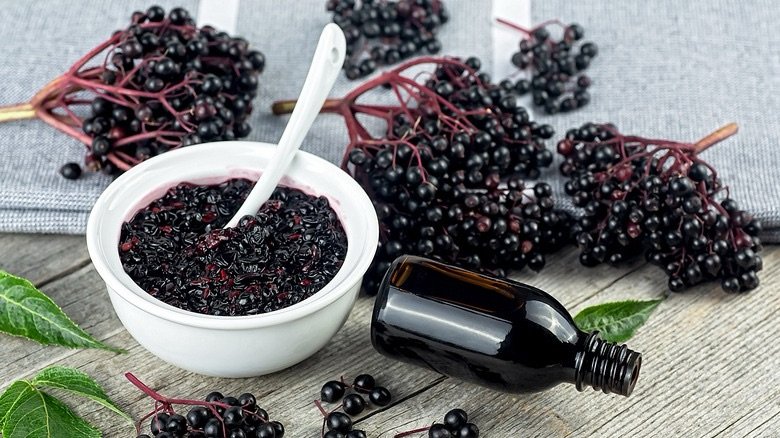
What Exactly Is an Elderberry?
I used elderberry syrup for years before I ever stopped and asked myself, “Wait… what even is an elderberry?” All I knew was that it helped me through cold season and made me feel like I was doing something smart for my body. But once I started diving deeper—especially when I began growing elderberries myself—I realized just how little people really know about this plant.
So let’s break it down. If you’ve ever found yourself wondering what exactly elderberries are, where they come from, or how to recognize the plant, you’re in the right place. I’ll walk you through everything I’ve learned the hard way—so you don’t have to dig through outdated articles or guess based on a grocery store label.
By the end of this, you’ll be able to recognize elderberries in the wild (or your backyard), know which ones are safe, and understand why this powerful plant has been used for centuries for way more than just syrup. Let’s get into it.

What Plant Do Elderberries Come From?
Elderberries grow on a flowering shrub from the Sambucus genus. The most well-known species is Sambucus nigra, often called European black elderberry. If you’re in the U.S., chances are you’re seeing either Sambucus canadensis(American elderberry) or a hybrid of the two. These plants are tall, bushy, and loaded with medicinal history.
Here’s what I didn’t know at first: elderberries don’t grow on little garden-style berry bushes like raspberries or blueberries. These plants are big, often reaching 6 to 12 feet tall, and they have a woody, multi-stemmed structure that makes them look more like a small tree than a soft-stemmed shrub.
Each branch produces wide, flat clusters of small, cream-colored flowers in late spring. A few months later, those flowers turn into drooping clusters of dark purple to nearly black berries. That’s the part most people are familiar with—but the rest of the plant has just as much to teach you.
Where Do Elderberries Grow Naturally?
One of the coolest things about elderberries is how widespread they are. Once you learn what they look like, you start noticing them everywhere—along creeks, in ditches, at the edge of wooded trails, even beside highways. They thrive in all kinds of wild spaces, especially in zones 3 through 9, which covers most of the U.S.
They like:
- Full sun to partial shade
- Moist but well-drained soil
- Room to spread (they can colonize an area fast)
I’ve seen them growing wild in Missouri, Minnesota, and even parts of Texas. They’re native to both North America and Europe, which is part of why they’ve been used traditionally in so many cultures.
If you’re thinking about growing them yourself, chances are they’ll do just fine in your yard—especially if you’ve got good sun and decent drainage. They’re surprisingly low-maintenance once they’re established.

What Does an Elderberry Look Like?
This is where it gets interesting—and where the details matter.
The berries themselves are small, round, and dark purple—almost black—when fully ripe. They grow in large clusters on reddish stems, and when the plant is heavy with fruit, those clusters droop down slightly under the weight. If the berries are green or red, they’re not ready yet—and they’re definitely not safe to eat.
But the elderberry plant isn’t just about the berries. Here are a few visual clues that help you spot it:
- Leaves – Opposite pairs with 5 to 9 leaflets per stem. Each leaflet is pointed and serrated along the edges.
- Stems – Light brown to grayish with soft bark. If you cut one open, it has a distinctive soft pith inside.
- Flowers – Flat, umbrella-like clusters of tiny white or cream blooms in early summer.
- Height – Grows between 6 to 12 feet tall and almost just as wide.
Once you’ve seen a true elderberry plant in full bloom or full fruit, it’s hard to forget. That unique combo of white flowers, purple berries, and red stems is one-of-a-kind.

How to Identify an Elderberry Plant in the Wild
Once you know what to look for, spotting an elderberry plant in the wild becomes second nature. But it’s important to get it right—especially if you plan to forage.
Here’s what helps me most when identifying elderberries outdoors:
- Opposite leaf patterns – Each pair of leaves grows directly across from each other on the stem. If they’re alternating, it’s not elderberry.
- Serrated leaf edges – The edges have a toothy look, kind of like a saw blade.
- Flat-topped flower clusters – Elderflowers bloom in early summer and look like tiny white stars grouped into large umbrella-like clusters.
- Drooping purple-black berries in late summer – Hanging from red or burgundy stems.
- Soft pith inside the stems – If you break a branch, the inside is soft and white.
Elderberries love the edges of wild areas—think roadside ditches, creek banks, or forest clearings. I’ve found some of my favorite wild elderberries while hiking rural trails in late July. If you’re looking for a full picture of how elderberries are used and why they’ve gone mainstream, check out my detailed breakdown of why elderberries are getting so much attention lately.
Just be cautious. Not every lookalike is safe. That brings us to the next section…

The Different Types of Elderberries
Not all elderberries are created equal. Some are great for syrups and teas—others you don’t want anywhere near your kitchen.
Let’s go over the main types you’ll run into:
1. Sambucus nigra (European black elderberry):
This is the type most people are familiar with. It’s commonly used in supplements and DIY syrup recipes. Berries are dark and rich in antioxidants.
2. Sambucus canadensis (American elderberry):
Very similar to S. nigra and native to the U.S. This is the one I grow and forage most often. It has slightly smaller berries and can grow quite large in ideal conditions.
3. Sambucus racemosa (Red elderberry):
Here’s where you need to be careful. The berries from this species are not safe to eat—even when cooked. You’ll usually find this one in mountainous or colder regions, and its berries tend to form in cone-shaped clusters rather than flat-topped ones.
4. Ornamental hybrids:
Some elderberry plants are bred just for their flowers or foliage (like purple leaves). These may or may not produce fruit, and the berries aren’t usually used for consumption.
If you’re planting your own, always choose a named edible variety that’s bred for fruit production. That way, you avoid any surprises and get the best yield.
Elderberry Plant vs Poisonous Lookalikes
If you plan to forage, this is the section you need to read. While elderberries are safe when handled correctly, some plants that look similar can be downright dangerous.
Here are the big three to watch out for:
1. Pokeweed –
The berries look similar at a glance, but pokeweed grows on a single thick stalk, not a woody shrub. Its berries grow on a bright pink stem and the juice is staining purple. Extremely toxic. Avoid at all costs.
2. Water hemlock –
While not a direct visual twin, some folks confuse its young shoots or leaves with elderberry. Water hemlock is one of the most toxic plants in North America.
3. Red elderberry –
We mentioned this above, but it deserves repeating: red elderberries should not be eaten, even when cooked. Their cone-shaped berry clusters are a good clue that you’re not dealing with black elderberry.
When in doubt, don’t forage it. Stick to elderberries you’ve grown yourself or buy from a reputable source. Better safe than sorry.

Are Elderberries Trees or Bushes?
This one trips up a lot of people—including me when I first started growing them.
Technically, elderberries are multi-stemmed shrubs, not trees. But when left to grow wild or mature over several years, they can get tall enough (sometimes 10–12 feet) to look like a small tree. The confusion makes sense.
Here’s how to tell the difference:
- Bush – Multiple stems growing from the ground, flexible and often sprawling
- Tree – Usually one central trunk with a clearly defined canopy
- Elderberries almost always grow in a bush form unless trained or pruned otherwise
In my own yard, I let one go a bit wild and now it’s easily over my head—and it’s still technically a shrub. But either way, it’s producing gorgeous flower heads and loads of berries, so I’m not complaining.

What Parts of the Elderberry Plant Are Safe?
This is a question I wish more people asked upfront—because not everything on the elderberry plant is safe to use or consume.
Here’s the breakdown:
✅ Safe (when properly prepared):
- Berries – Only when fully ripe and cooked. Raw berries contain toxic compounds that can cause nausea or worse. Once they’re cooked, though, they’re totally fine and packed with benefits.
- Flowers – These are totally safe and often used in teas, tonics, and skincare.
🚫 Not safe to eat or use internally:
- Stems and leaves – These contain cyanogenic glycosides, which can release cyanide when metabolized.
- Roots and bark – Also toxic if consumed.
- Unripe berries – Green or red elderberries are still toxic, even with cooking.
When I make my own syrup or tea, I’m always extra careful to remove every single stem from the berries. It’s a bit tedious, but it’s worth it for safety—and for taste, honestly.
The bottom line: only the cooked ripe berries and the delicate elderflowers are safe for regular use. Everything else? Best left alone.

Elderberry Flowers: More Than Just Pretty
Most people think of elderberries for the fruit—but the flowers are incredibly useful too, and they show up first in the season.
I love how elderflowers look in bloom—giant, flat-topped clusters of tiny white blossoms that smell faintly sweet and a little spicy. If you’ve ever walked past a blooming elderberry bush in late spring, you know what I mean. It’s impossible not to stop and sniff.
So what can you do with them?
- Elderflower tea – Light, floral, and slightly citrusy. Great hot or iced.
- Homemade cordials – Mixed with lemon and sugar for a refreshing summer drink.
- Skincare – The flowers are often infused into oils and lotions for their antioxidant properties.
- Cough and cold blends – Used in combination with herbs like chamomile or yarrow.
The best part is that harvesting the flowers doesn’t hurt the plant—though if you take too many, you’ll get fewer berries later. I usually pick a few clusters from each plant and leave the rest to turn into berries.
It’s wild to think one plant can give you two separate herbal ingredients, but that’s exactly why I love elderberries so much.

How to Grow Elderberries at Home
When I first planted elderberries in my backyard, I had no idea how easy they’d be to grow. These things are tough—and once they’re established, they almost take care of themselves.
Here’s what I’ve learned from growing them over the past few years:
1. Pick the right spot.
Elderberries love full sun but will tolerate some shade. Give them at least 6–8 hours of direct sunlight for the best berry production.
2. Think wet—but not swampy.
They prefer moist, well-drained soil. If your area tends to dry out, a layer of mulch around the base helps a ton.
3. Give them room.
These aren’t dainty bushes. They’ll spread wide, so plant them about 6 feet apart. Once mature, they can easily hit 10 feet tall and just as wide.
4. Be patient.
You usually won’t get fruit the first year. But once they settle in, the yearly harvests can be impressive.
5. Get a second plant.
Most elderberries are not self-pollinating, so planting two different varieties helps ensure a bigger, more reliable harvest.
And here’s a pro tip I learned the hard way: net your plants before the birds find them. I’ve lost whole clusters to hungry starlings who seem to know exactly when the berries ripen.
You can order Elderberry plants online from Weaver Family Farms Nursery
What Time of Year Can You Harvest Elderberries?
This depends on where you live, but in general, elderberries ripen between mid-July and early September.
Here’s how I know when mine are ready:
- The clusters droop downward under the weight
- The berries are deep purple or almost black
- They come off the stem with a gentle tug
- There’s a slightly sweet, earthy smell in the air near the bush
Don’t wait too long though—if the birds start getting bold or the berries begin to shrivel, you’ve missed peak ripeness.
I usually harvest in the early morning when everything’s still cool and shaded. Then I get them washed, de-stemmed, and either frozen or cooked down into syrup within 24 hours.
If you want more tips on harvesting, prepping, and storing your elderberries, I talk about it a bit in my full elderberry breakdown article too.
What Do Elderberries Taste Like?
If you’ve never tasted elderberry before, here’s a heads-up: they’re not sweet like blueberries or strawberries. Raw elderberries are actually bitter and a little earthy—which is part of why no one eats them fresh off the bush (aside from the fact that raw ones can make you sick).
Once they’re cooked, though? That’s a different story.
Cooked elderberries have a rich, tart flavor that reminds me a little of blackberry mixed with cranberry, with this deep, almost wine-like base. That’s why they work so well in:
- Syrups and jams
- Elderberry wine and cordials
- Gummies
- Tea blends
- Pie fillings (yes, it’s a thing!)
I’ve made a homemade elderberry syrup with cinnamon, clove, ginger, and raw honey that even my picky kids will take without a fight. It’s got just the right amount of tang and sweetness—and it feels like something good is happening every time I take a spoonful.
So no, elderberries aren’t the type of fruit you eat by the handful. But once you try them in a well-balanced recipe, you’ll understand why people have cooked with them for generations.

Why Knowing What an Elderberry Is Actually Matters
There’s something really satisfying about learning to identify the things that grow around you. Elderberries, for me, were the start of that journey.
Before, I just saw bottles of syrup on a shelf and assumed they were another trendy health product. But once I learned what elderberries actually were, how they grew, and how to use them safely—I started seeing them as more than just an ingredient. I saw them as part of a bigger shift toward natural living, seasonal wellness, and personal responsibility.
Knowing what elderberries really are matters because:
- It helps you avoid unsafe lookalikes
- It empowers you to make your own remedies
- It builds respect for the plants we rely on
- And let’s be honest—it makes you feel kind of like a backyard herbalist
If you’re just now diving into elderberries, I definitely recommend checking out my full post on what elderberry is and why it’s so popular right now. It goes beyond plant ID and dives into the cultural and wellness side of it all.
And if you’re ready to start using elderberry yourself, whether that’s through growing, foraging, or making your own syrup—welcome to the club. You’ll be glad you did.
As an Amazon Associate we earn from qualifying purchases through some links in our articles.